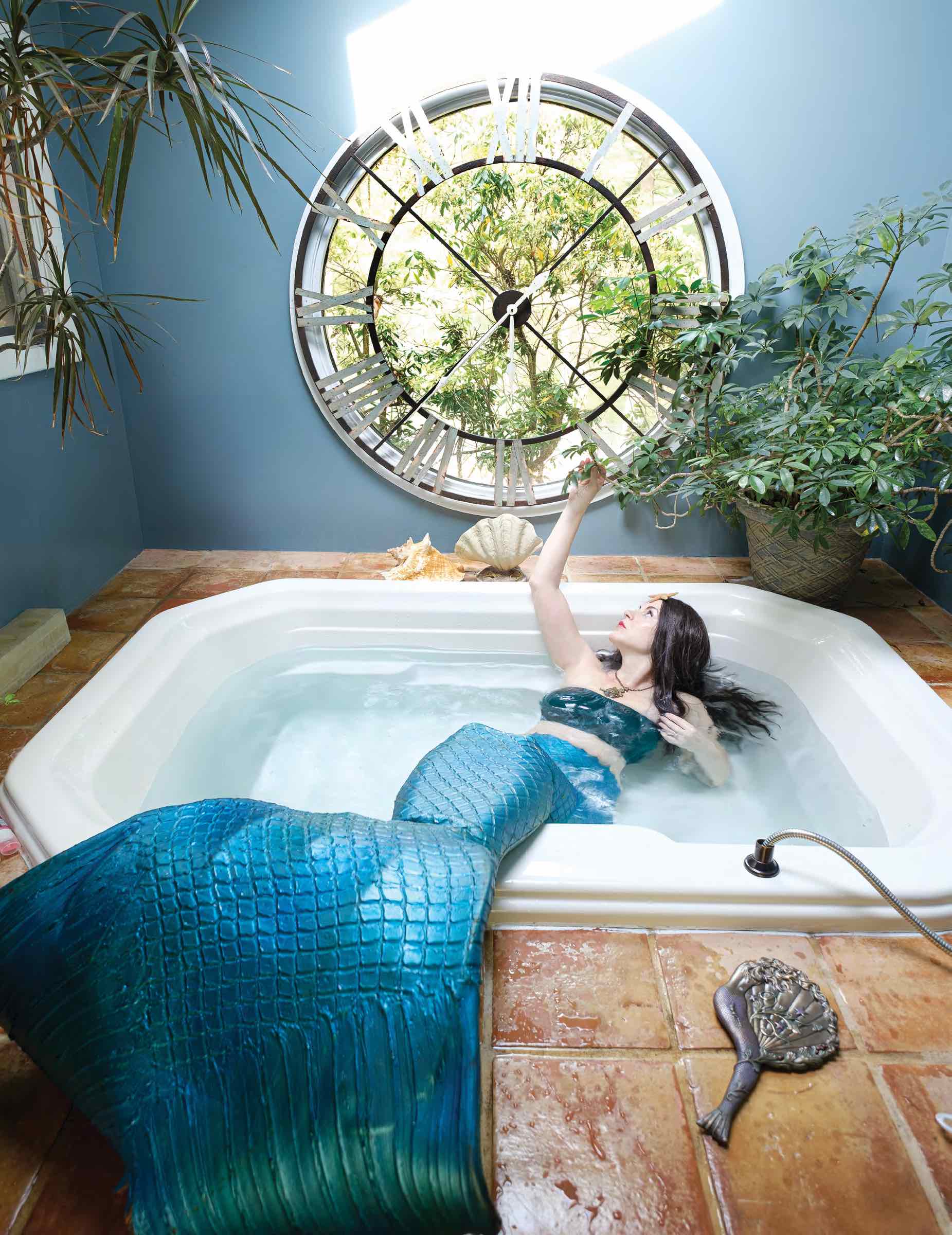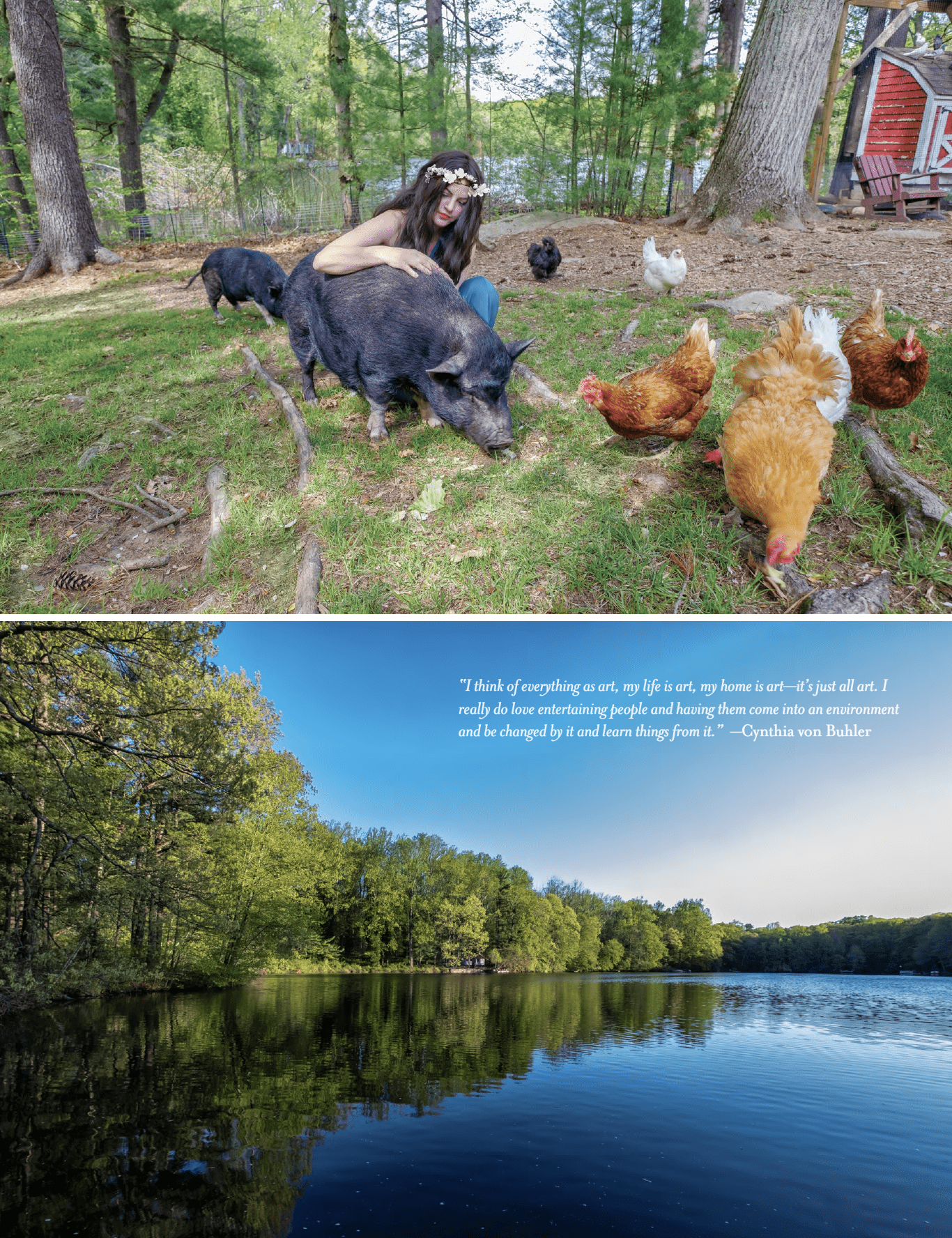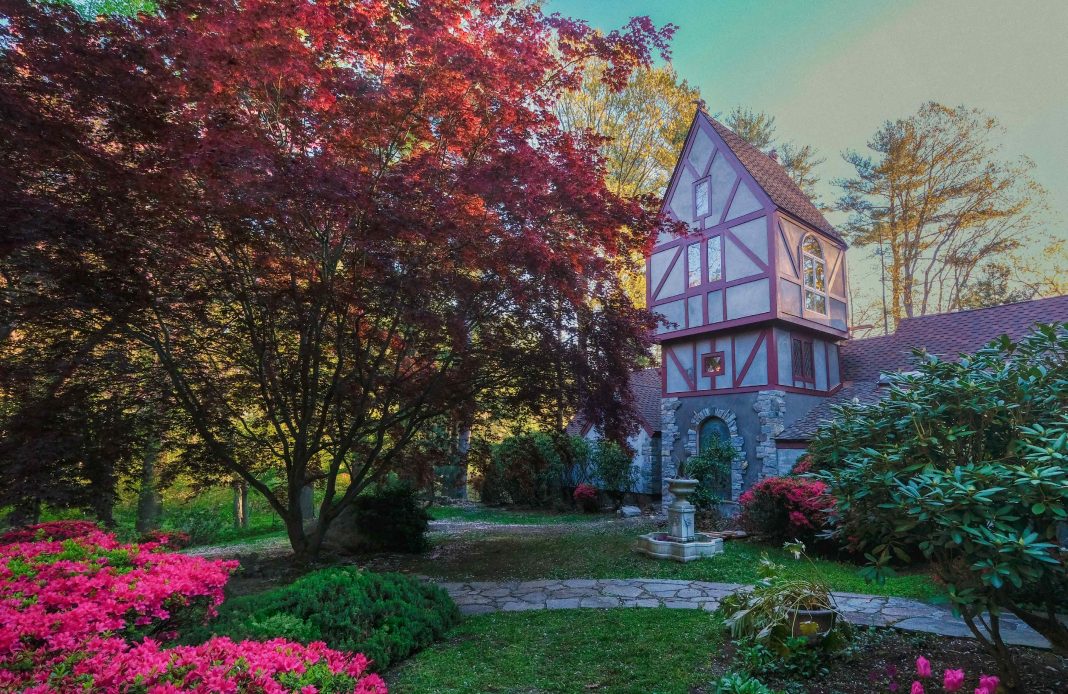PHOTOGRAPHY BY STEVE PARKE
Even among visionaries, artists who can create a reality for themselves as rich and lovely and magical too as their dream life, Cynthia von Buhler stands apart. A painter and playwright, graphic novelist, illustrator, impresario, and more, she both seeks inspiration from her environment and carefully crafts it to suit her artistic needs and whimsies. In von Buhler’s life, personal space becomes public and central to the creation of her work. It may not be too much of an overestimation to liken her estate outside New York City to a fantastical stage set; after all this is where she orchestrated one of her greatest triumphs, the legendary, long-running show The Illuminati Ball.
Here, in the sprawling structure von Buhler shares with her husband, the acclaimed jazz violinist Russell Farhang, crimson-colored aerialist silks hang from the soaring, wood-beamed ceiling of the great room. Here, on the seven-acre property, dozens and dozens of doves—symbols not only of magic or peace or love but also their mistress’s commitment to animal activism—fly free during the day, returning to the comfort of their coops at night. Here, a lake and wetlands enwrap the German Tudor-style house on three sides, exactly the kind of landscape an artist would want to muse over from the tower she is building simply because her home “needs it.”
“I’ve set up a few houses in my life,” von Buhler says. “I’m a little house obsessed. When we came to see this place, we were blown away by it. It has this massive fireplace, so big you could cook Hansel and Gretel in it, and it’s in the middle of the woods. The driveway is a mile long, so to get to the house you have to drive through these great big creepy trees.” In what must be her trademark speaking style, so fast it’s almost breathless and full of good humor, she adds, “I’m working on a middle-grade book right now. It’s a graphic novel, about a girl who is half-tree and half-human, and the reason I started working on that is because I’m surrounded by the woods and the woods are just speaking to me.”
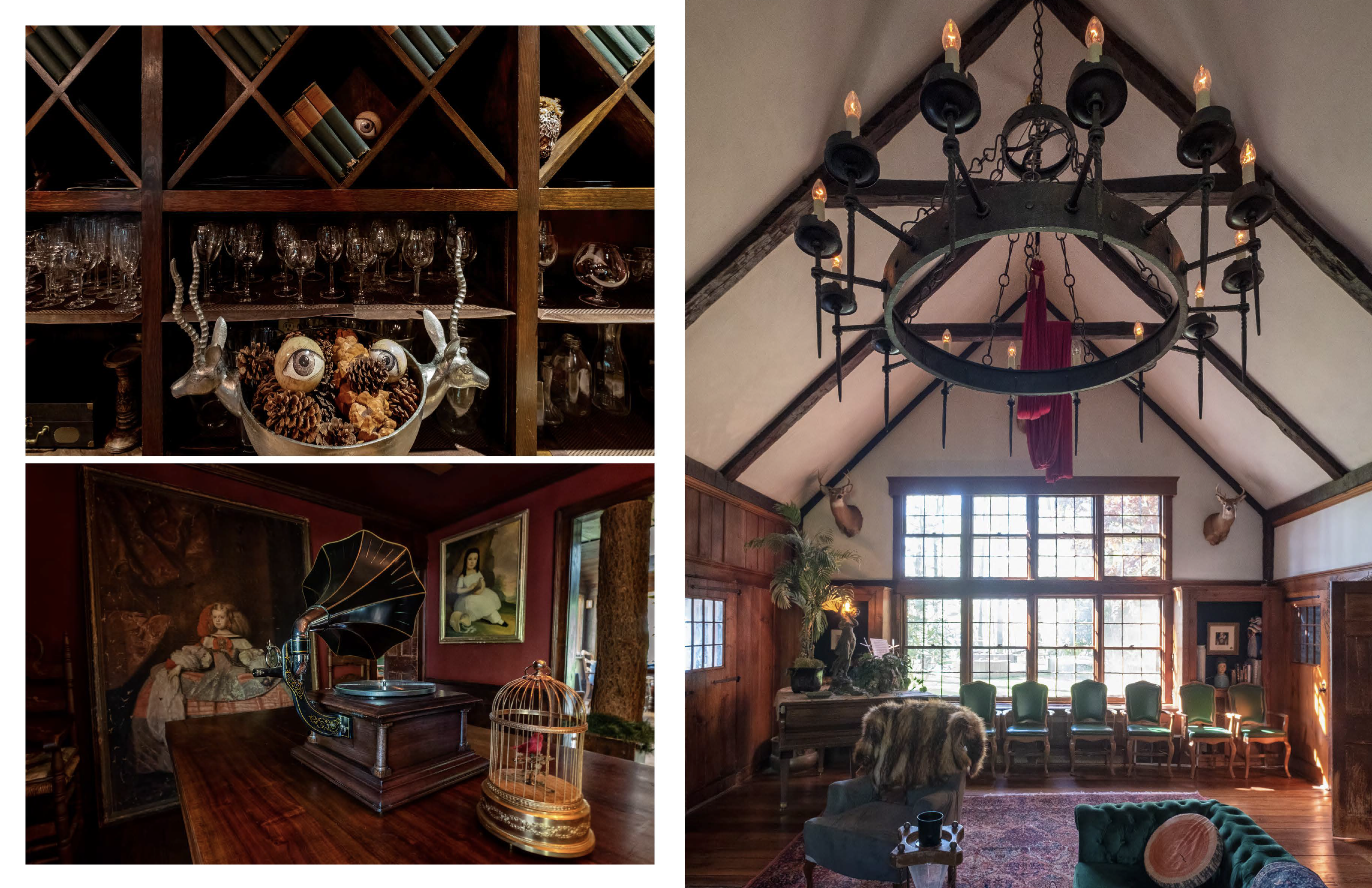
Although she’s known for tossing fabulous parties and her high-powered collaborations with people like Amanda Palmer—for whom she illustrated the 2011 graphic novel Evelyn Evelyn: A Terrible Tale in Two Tomes—von Buhler calls herself an introvert. She can spend months and months alone, surrounded by animals and nature, engrossed in the act of creating. This could explain her drive to create a tower for her home, a place where she can lock herself away, a modern-day Rapunzel of sorts, producing scads of beautiful, provocative art rather than locks of golden hair.
“The inside is going to be a library,” von Buhler says of the architectural feature, which is still under construction. “It’s quite tall. It’s going to have an opening in the ceiling that goes all the way to the top, with a chandelier hanging down, and a spiral staircase. But the first floor has double-height ceilings, and that will be the library, and it will have a fireplace and books everywhere. And then up the stairs will be a sort of parapet, looking down into the library, and that room is all glass, with beautiful arched windows, and there’s a deck off that facing the lake in the back. That’s going to be my little art studio where I can draw and paint and do those kinds of things.”
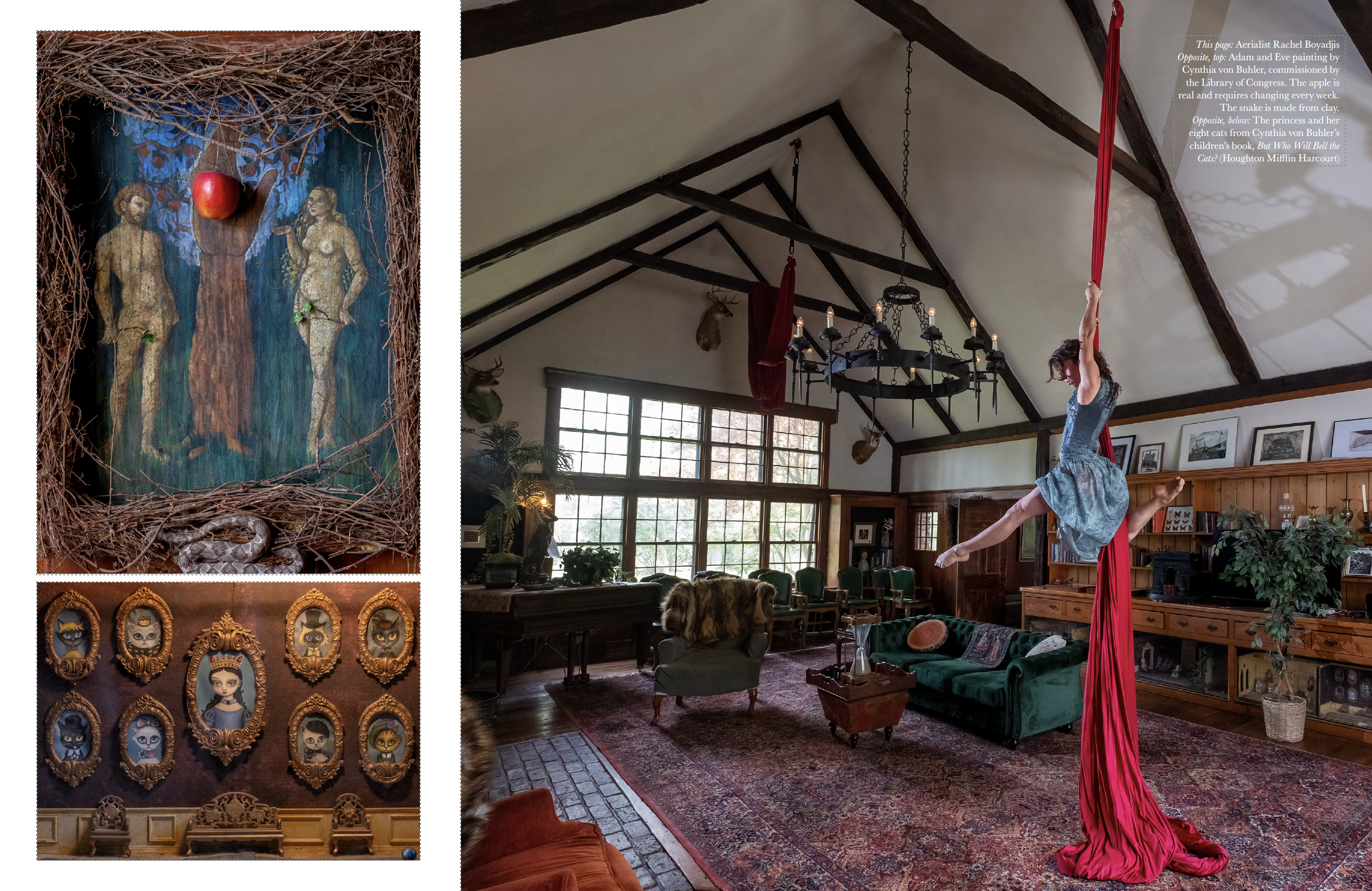
A fan of old materials, both for the histories they carry and how well they tend to be made, von Buhler is using mostly reclaimed supplies in the tower’s construction. That includes antique diamond-paned, leaded-glass windows purchased from flea markets and the owner of a Long Island castle where they once hung and, what may turn out to be the structure’s showpiece, a stunning arched silver-sided door that resembles something one might have seen in the Bastille. She bought the tower door, which is by Peer Smed, a famous Danish silversmith, off Facebook marketplace. “It has a little speakeasy peephole, with a Tiffany window inside that opens,” von Buhler says. “And then the other side of the door facing into the house is all beautiful wood, so I’m going to match the wood on the inside of the library to the color of the stain on that side of the door.”
If it all seems almost overwhelming, this endlessly intense dedication to art and beauty and spaces that seamlessly combine both, von Buhler comes by it naturally. One of six children born to deeply creative parents, she grew up in the Berkshires of Massachusetts, a milieu dense with summer stock theatrical productions. (Her high school graduation was held at Tanglewood, a live music venue known for being the summer home of the Boston Symphony Orchestra.) As soon as von Buhler could hold a paintbrush or pick up scissors, she was doing so, often in the service of family art projects, like a massive papier-mâché witch she recalls them all making one Halloween.
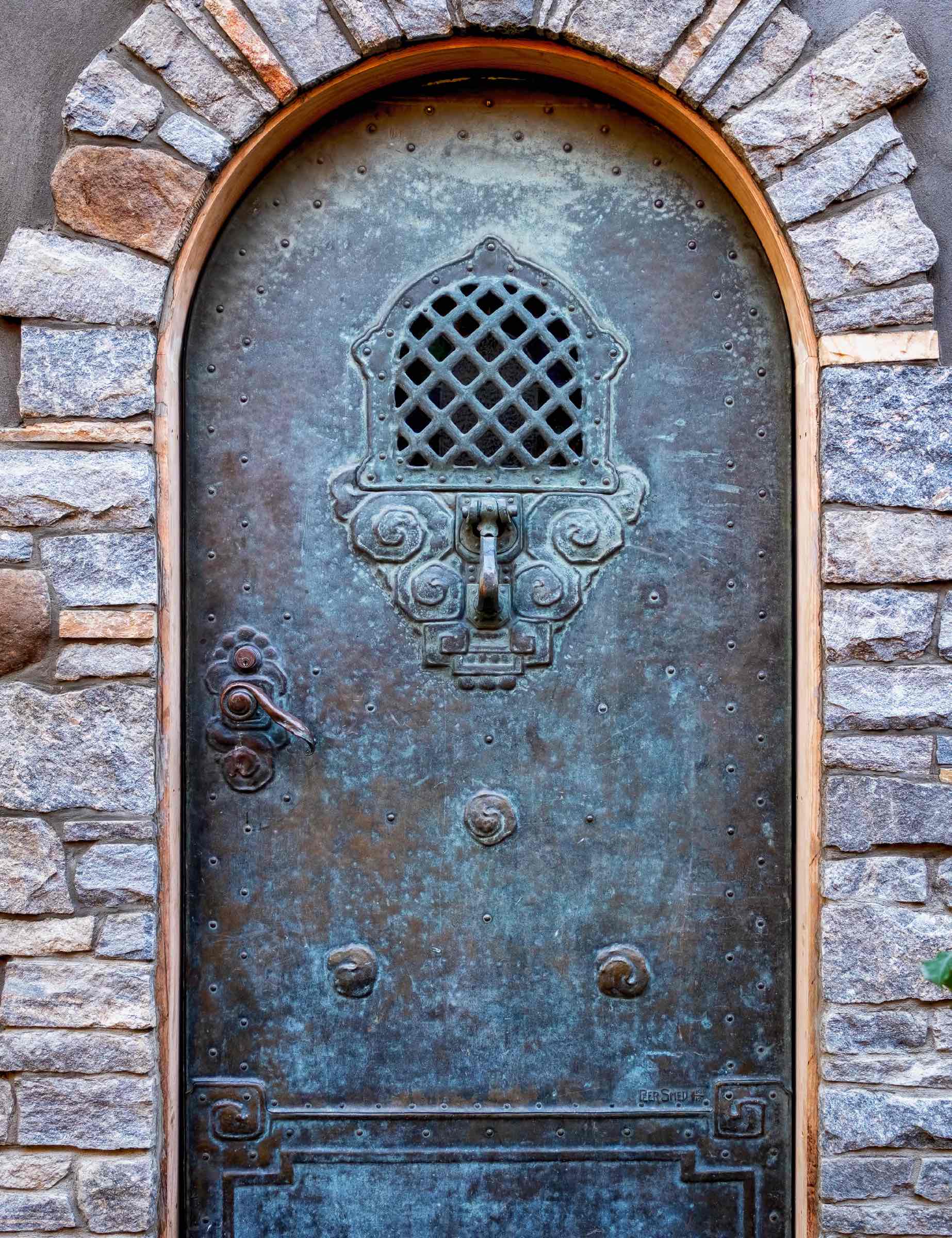
According to von Buhler, rather than posters of kiddie favorites Barney or SpongeBob, on her bedroom walls growing up were taped prints by Old Masters like Raphael and Michelangelo. To this day, her painting style—save for the application of mixed media—evokes the Renaissance period. Of course, it can only have nudged von Buhler’s interests further in this direction to hear from her grandmother that the family is descended from the Sforzas, a Medici-like clan of Italian royals. “I would assume because we’re not rich aristocrats, we’re related through an illegitimate line,” she says, laughing. “There’s this famous painting, Lady with an Ermine, by Da Vinci. It’s a portrait of Cecilia Gallerani, who was Ludovico Sforza’s mistress, and so I always felt like maybe we’re related to her.”
Whether or not there is an actual familial connection to the fabulous Sforzas, von Buhler is on occasion called Countess by the press, a title bestowed on her following her college days, which she spent studying illustration at London’s Richmond College and the Art Institute of Boston. The story of how her lofty appellation came to be is, like most of von Buhler’s tales, engaging and slightly outrageous. Born Cynthia Carrozza, she took the surname of her first husband, Adam Buhler, which morphed into von Buhler after friends began calling the couple’s rambling, Gothic-style Boston home Castle von Buhler. From there—perhaps, one imagines, with a little nudge from von Buhler herself—the noble designation Countess was soon added.
In the years since her salad days, von Buhler has produced clients ranging from The New Yorker to Rolling Stone and The New York Times; a half-dozen children’s picture books; cover art for comic, children’s, and adult books, as well as the CD An Evening With Neil Gaiman and Amanda Palmer and a steady array of solo art exhibits and street art. Most recently she has concentrated her prodigious talents on writing and directing immersive theatrical productions, including The Illuminati Ball, which ran for three years in both her home and in Brooklyn, New York, and also took form as a graphic novel.
At its heart a mediation on animal rights, the play was inspired by a 1972 surrealist ball thrown by Baron and Baroness Rothschild at their French chateau. von Buhler’s attendees, who paid $350 for tickets, were blindfolded and then driven to the location in limo buses and fed a vegan meal masquerading as meat. Cues—some subtle, some not—to the event’s real agenda were everywhere. “I had these deer heads on the wall because my house is sort of like a hunting lodge,” von Buhler says. “I don’t believe in taxidermy anymore, but I needed them for the story line. I put long crystal tears hanging from the faces, so they were all crying. They were distressing because they’re sad, but they were also beautiful in their sadness, and they also taught you something. With set design I like to educate a little bit.”
While von Buhler has no plans to reboot The Illuminati Ball, NBC has come nosing around about transforming the play into a reality series. So, as she says, “never say never.” Another network has also shown interest in von Buhler’s The Girl Who Handcuffed Houdini, a 2018 graphic novel and play that stars the indomitable Prohibition-era detective character, Minky Woodcock. For that work, von Buhler learned Houdini’s infamous—and dangerous—water-torture trick. Who knows what esoteric knowledge von Buhler will pick up as she crafts her next Minky Woodcock effort, The Girl Who Electrified Tesla?
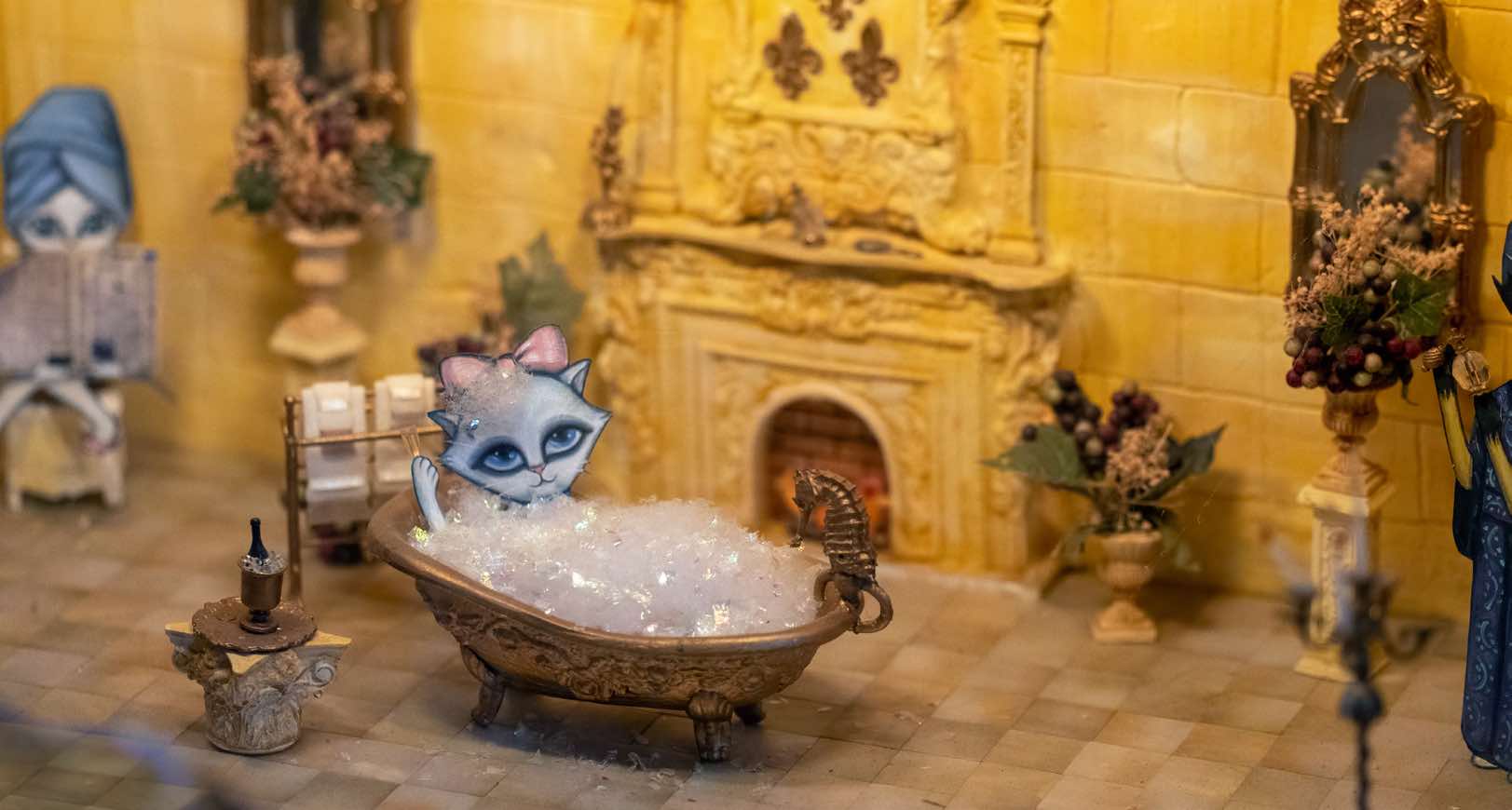
In the meantime, von Buhler continues work on her latest passions, including wildlife rehabilitation, for which she is licensed in the state of New York. A true animal lover, she shares her home and property with not only the aforementioned doves but two potbellied pigs named Nini and Panda; a posse of cats; a dog; a rabbit, Agatha, who was named after the mystery novelist and co-starred in The Girl Who Handcuffed Houdini; and a brood of chickens, which includes a rooster with the obsessive habit of peering into her bedroom window. All are rescues, including the fish swimming in the gorgeous stone pond in front of her house.
As for her tower, von Buhler believes construction on it will be wrapped up around spring of next year. The tower and pond are both being built by Roman Lojano and his sons—
R. Lombardi Masonry LLC, as they’re known—whom she adores. As much as anything she has ever done, it promises to be a work of enchantment, the kind of space that causes visitors to involuntarily sigh at its splendor, as if seeing fireflies on a sultry summer night. “I love entertaining people, so I think of my life as showing them a bit of magic, showing them something special,” von Buhler says. “In my theater I do that, and in my art I try to do that, and in my life too.”
After a short, uncharacteristic pause, von Buhler adds, “People often ask, Would you make art if you were on a desert island? I’ve thought hard about that, and I think what I’d probably
do would be make something that would be intriguing and entertaining to the animals on that island. I think of everything as art, my life is art, my home is art—it’s just all art. I really
do love entertaining people and having them come into an environment and be changed by it and learn things from it.”
Find more at cynthiavonbuhler.com.
